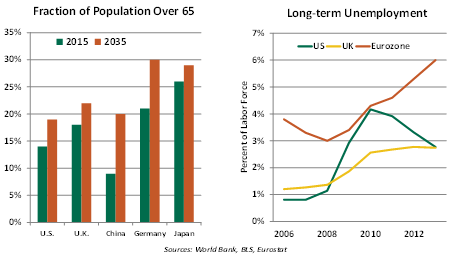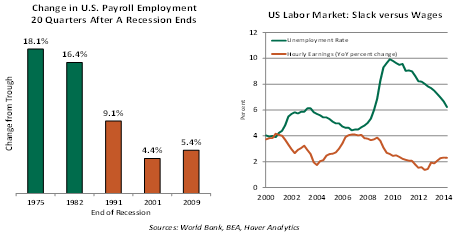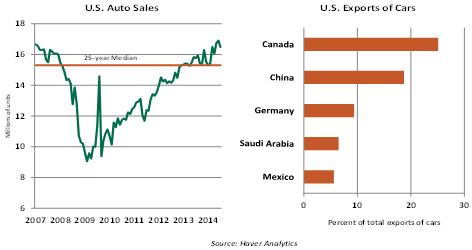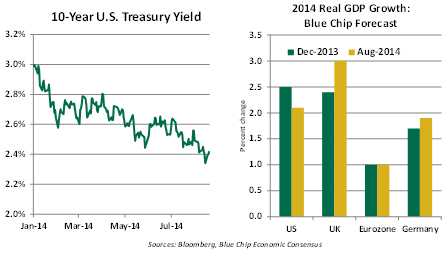- The View from Jackson Hole
- U.S. Auto Sales: Tailwinds Will Prevail
- The Mystery of Long-Term Bond Yields
The area around Jackson Hole, Wyoming, is among the most picturesque in the United States. Mountain vistas, grand forests and pristine waters provide a great setting for hikers, but you must keep your eyes out for bears.
This weekend, the trails around Jenny Lake will be filled with clusters of central bankers from around the world attending the Federal Reserve’s annual summer retreat. The guest list and the times will make this an especially interesting edition. The tone of the conversations will likely be less dire than it was during the crisis years, but the fear of bears remains.
There are three main themes that will likely dominate the discussions. The first of these is the official theme of the program, “Re-Evaluating Labor Market Dynamics.” Although the Federal Reserve is the only major central bank with an explicit mandate to promote maximum employment, others shape their policies to pursue this objective. Doing so requires answering two difficult questions. What is maximum employment, and how far is the current situation from this ideal? And is the job market now operating very differently than it has in the past?
Measuring labor market slack is challenging. The aging of the post-war generation is putting downward pressure on labor force participation. The community of those working part-time but who desire full-time work remains elevated. Wages are growing very modestly. All these trends must be factored in when considering how close an economy is to full employment.
At one level, the Great Recession and the uneven recovery that followed have dampened the demand for labor. To the degree that central banks can help to engineer more robust growth, opportunities for employment should surely follow. But are there structural issues that limit this translation?

There remains a substantial community of workers in both Europe and the United States who have been unemployed for a long time. Hysteresis, a term borrowed from the natural sciences, has been used to describe the atrophy of skills and networks that can affect those who have been idle for an extended period. Workers with more-modest education have found the current environment especially challenging, a situation that Janet Yellen called “the phenomenon of polarizing” in her opening remarks this morning.
Do these groups represent a potential source of labor supply? The pace of change in technology and globalization certainly challenges us all to remain current, and those who are detached from the workplace face an extra disadvantage. But stronger growth might certainly increase the attraction to workers and firms of pursuing retraining and eventually kindle increases in labor force participation.
The choices made by workers may be evolving, though, further complicating the analysis. Retirements are most often not related to weak economic performance, and part-time work may fit better with certain industries and worker preferences.
The papers presented at Jackson Hole will examine whether recent developments have fundamentally changed the market for labor. Encouragingly, though, the last three expansions in the United States have seen job creation start slowly but eventually gather sufficient steam to bring unemployment down to less than 5%. This time may be different but not so different that old ideas about equilibrium need to be completely discarded.

It is worth noting that central banks face certain limitations in trying to promote full employment. Supply and demand for workers is influenced by a host of public and private policy choices on education, taxes, trade and investment. In particular, the structural inflexibility of labor markets in certain parts of the world has severely hindered the effectiveness of monetary policy as it tries to get people back to work.
The second theme that will occupy the delegates at Jackson Hole is how labor market performance and inflation will be linked in the quarters ahead. The Phillips curve (which postulates an inverse relationship between unemployment and inflation) no longer holds in the long run. And in the short run, some of the structural labor market shifts discussed earlier may be changing the temporal relationship between employment levels, wages and inflation.
 The third and final consideration is to what degree monetary policy needs to be coordinated internationally. Foreign central bankers now make up almost a third of those attending the Jackson Hole conference, a clear nod to the global linkage of markets. Last year, Governor Augustin Carstens of the Bank of Mexico highlighted the consequences of monetary policy in developed markets for economic performance in emerging markets.
The third and final consideration is to what degree monetary policy needs to be coordinated internationally. Foreign central bankers now make up almost a third of those attending the Jackson Hole conference, a clear nod to the global linkage of markets. Last year, Governor Augustin Carstens of the Bank of Mexico highlighted the consequences of monetary policy in developed markets for economic performance in emerging markets.
Interest rates should certainly not be set in a vacuum. But given the uncertainties involved with determining the progress of domestic variables toward their targets, and the limitations of mandates given to central banks, optimizing policy internationally still seems to be a difficult bridge to cross.
These are pressing questions, to be sure. But those assembled should pause for at least a moment to congratulate themselves for the important economic progress that has been made since 2009. This backdrop, along with the view of the Grand Tetons, should provide calming perspective for the challenging times that lie ahead.
U.S. Auto Sales: Acceleration or Moderation?
It is noteworthy that there is an impressive recovery of U.S. auto sales in place, while the housing sector remains sluggish. U.S. auto sales collapsed during the Great Recession to a mere 9.0 million annualized pace, vastly different from the historical trend. More recently, sales of autos matched the pre-crisis sales pace. Looking ahead, the outlook for the auto industry is promising, but at the same time there are forces at play that could trim momentum.
Sales of autos touched the 16.9 million annualized mark in June and slowed slightly to 16.5 million units in July. New car loans are currently being extended at historically low rates (4.5% in the second quarter of 2014).

The average age of a passenger vehicle moved up to 11.4 years in 2013 from 9.7 years in a span of 10 years. Improved quality of cars is a partial explanation for the increase in the age of cars on the road. Overall, the average age of cars suggests that there is significant pent-up demand that could boost car sales in the quarters ahead.
 Used cars are always an alternative to new cars as long as they are less expensive. Year-to-date, the price index of used cars moved up after recording declines in each of the prior two years, enhancing the attractiveness of new cars. Technological improvements of cars such as integrated Bluetooth and rear-view cameras are appearing in lower-end passenger vehicles. These features enhance the case for a new car in a low-interest-rate environment, particularly for owners of aged vehicles who have been fence-sitters.
Used cars are always an alternative to new cars as long as they are less expensive. Year-to-date, the price index of used cars moved up after recording declines in each of the prior two years, enhancing the attractiveness of new cars. Technological improvements of cars such as integrated Bluetooth and rear-view cameras are appearing in lower-end passenger vehicles. These features enhance the case for a new car in a low-interest-rate environment, particularly for owners of aged vehicles who have been fence-sitters.
Despite these positive factors encouraging expectations of growing demand for cars, there are negatives that can dampen future car sales.
Although auto sales show an unmistakable upward trend, the density of autos (number of registered vehicles per household) is disappointing – 2.02 vehicles per household in 2013 versus 2.13 vehicles in 2006. It is premature to label this trend as a structural development. The sharp drop in auto sales tied to the severity of the recession suggests that cyclical factors most likely outweigh structural influences.
Availability of shared cars in urban areas weighs negatively on demand for new cars. Also, surveys indicate that Millennials (those born between early 1980s and early 2000s) are less interested in owning a car compared with their parents and grandparents.
Auto loans increased nearly $220 billion in the last 15 quarters, and they reflect a large gain in sub-prime auto loans. There is a view that sub-prime auto loans will be problematic, much like sub-prime home mortgages. Subprime mortgages were significantly larger than auto loans, and re-possessed autos are less challenging than foreclosed homes. Delinquency of auto loans is close to the historical mean as of the second quarter of 2014, according to the Federal Reserve Bank of New York.
The Troubled Assets Relief Program, or TARP, legislation provided funds to revive the U.S. auto industry, which buckled during the Great Recession. Post-crisis, auto exports, in addition to domestic demand, came to the rescue of this industry. Exports of motor vehicles showed exceptional strength during 2010-2011, followed by moderate growth in 2012 before slowing considerably in 2013. There was a visible pickup in exports of cars in the second quarter of 2014.
Canada, China, Germany, Saudi Arabia and Mexico are the major export destinations of U.S. cars. Exports of cars to China accelerated from less than 10% of total cars exports in 2010 to roughly 19% in the second quarter of 2014. Auto sales in China ranks as the largest in the world, and purchases are largely credit-driven. Recent regulations to contain credit growth in China should reduce auto imports in the months ahead.
America’s love of cars is fading somewhat, but the age of cars on the road, a low interest rate environment and favorable hiring trends augur positively for car sales in the near term.
Wrong for the Right Reasons Last December, we projected that the 10-year U.S. Treasury yield would be at 3% by now. As of this writing the yield was hovering at around 2.4%, having fallen steadily since the beginning of the year. In reflecting on this variance, I think the evidence suggests that geopolitical stresses – and not economic fundamentals – are the driving force. If tensions revert to lower levels, one might therefore expect long-term yields to revert to higher levels.
Last December, we projected that the 10-year U.S. Treasury yield would be at 3% by now. As of this writing the yield was hovering at around 2.4%, having fallen steadily since the beginning of the year. In reflecting on this variance, I think the evidence suggests that geopolitical stresses – and not economic fundamentals – are the driving force. If tensions revert to lower levels, one might therefore expect long-term yields to revert to higher levels.
There have been many theories advanced that attempt to explain the drop in long-term U.S. yields. We covered a few of these in our June 6 commentary. But a few of the explanations offered seem inconsistent with hard data.
- There has been a suggestion that weakening expectations for the world economy have placed downward pressure on interest rates in many locations. But the Blue Chip forecasts show that expectations for the United States and the eurozone have not changed much between December and today.

- There has also been a sense that market expectations for Fed policy now show a later start and a more-shallow progression for interest rate hikes. But the futures markets for Federal funds through the end of 2015 do not look substantially different today than they did in January. From another perspective, the Fed’s “dot plot” summary of expectations has moved the first movement to an earlier point.
- Some also suggested that expectations of persistently low U.S. inflation were a contributing factor in the decline of long-term yields. But inflation is rising, and investors may soon demand compensation.
What seems left is the flight to quality from the myriad geopolitical skirmishes that have arisen this year. By their very nature, the course of these situations is terribly hard to predict. But should peace break out, our start-of-year forecast might start to look better and better.
Recommended Content
Editors’ Picks
EUR/USD clings to gains above 1.0750 after US data

EUR/USD manages to hold in positive territory above 1.0750 despite retreating from the fresh multi-week high it set above 1.0800 earlier in the day. The US Dollar struggles to find demand following the weaker-than-expected NFP data.
GBP/USD declines below 1.2550 following NFP-inspired upsurge

GBP/USD struggles to preserve its bullish momentum and trades below 1.2550 in the American session. Earlier in the day, the disappointing April jobs report from the US triggered a USD selloff and allowed the pair to reach multi-week highs above 1.2600.
Gold struggles to hold above $2,300 despite falling US yields

Gold stays on the back foot below $2,300 in the American session on Friday. The benchmark 10-year US Treasury bond yield stays in negative territory below 4.6% after weak US data but the improving risk mood doesn't allow XAU/USD to gain traction.
Bitcoin Weekly Forecast: Should you buy BTC here? Premium

Bitcoin (BTC) price shows signs of a potential reversal but lacks confirmation, which has divided the investor community into two – those who are buying the dips and those who are expecting a further correction.
Week ahead – BoE and RBA decisions headline a calm week

Bank of England meets on Thursday, unlikely to signal rate cuts. Reserve Bank of Australia could maintain a higher-for-longer stance. Elsewhere, Bank of Japan releases summary of opinions.